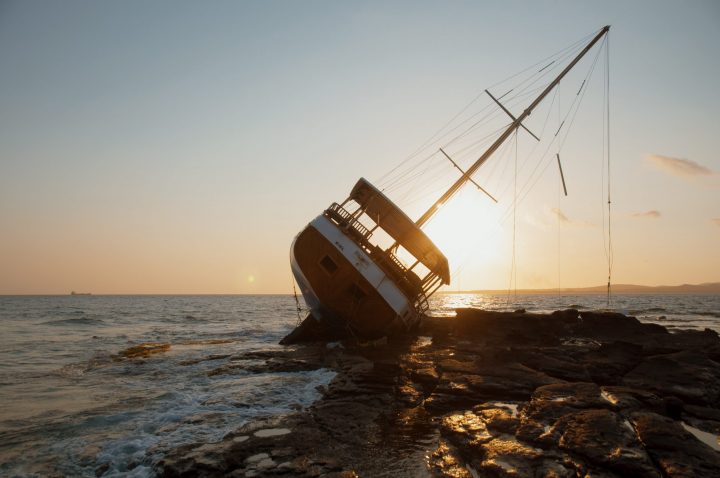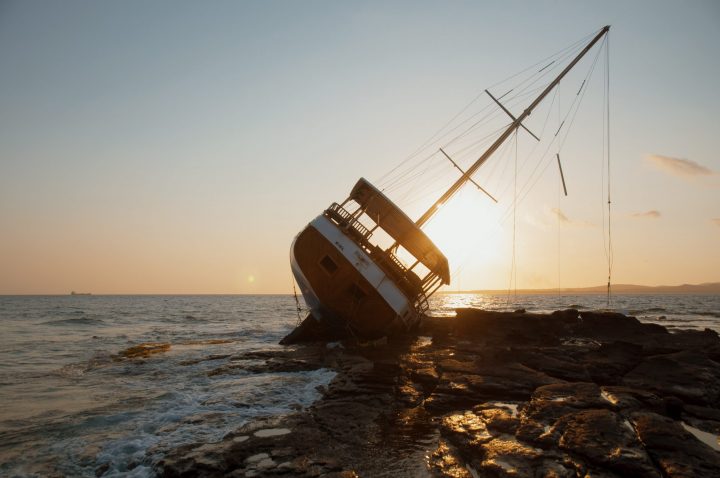There comes a time in every boat’s life when it isn’t worth fixing up. Sometimes this is a result of it being abandoned for a long time. Boats deteriorate rapidly when not kept up.
In other circumstances, the boat may not have been built to stand the tests of time, to begin with. Or it accidentally sank or has just run its clock out and is ready for the scrap heap. Whatever the situation, the time has come to scrap it. Here’s how to dispose of a boat that no one wants anymore.
Table of Contents
- The Problem – How to Dispose of Old Boat Hulls
- 5 Right Ways How to Dispose of a Boat
- How to Dispose of Boat? Any Way You Can, Legally
- FAQs (Frequently Asked Questions)

The Problem – How to Dispose of Old Boat Hulls
We’re all somewhat familiar with car junkyards and the process of scrapping old cars. The cars are stripped down, and the metal is recycled into new cars and components. The problem with boats is that they’re primarily made of fiberglass. And unfortunately, you can do nothing with fiberglass- it just gets cut down and hauled to the landfill.
Fiberglass is a wonderful material to build boats out of, but like all plastics, it never goes away. In the words of Practical Sailor, when looking at boat disposal options, at least wooden boats had the decency to rot away!
When you hear about boats being “recycled,” there is a little greenwashing occuring. The motors, tanks, wiring, and components can be stripped out and sold off or recycled. But the hull is generally just a huge chunk of plastic that no one wants.
To make matters worse, there’s a serious problem with derelict boats that few people want to talk about. Sure, some small trailer boats might be abandoned here and there. But the bigger the boats get, the bigger the problems they present.
Boats attract the romantic in all of us. Some people approach a project boat and think it will be a dream boat with just a little elbow grease. When they realize how much labor and money it will take to get it seaworthy–much less dream boat-worthy–they’re left with a problem. Project boats are hard to sell; they’re even hard to give away in many cases. Sometimes owners are left with no other choice but to walk away.
So now there’s an abandoned boat somewhere. The best case scenario is that it is left in a boatyard. Unfortunately, boatyards are full of abandoned boats whose owners have disappeared and stopped paying their bills. A worse case is the abandoned boat at a marina, which risks sinking. No dockmaster wants to deal with that problem, but many have to. And worse still are abandoned boats floating on their anchors, waiting for the next big storm to blow them away.
Many states have derelict boat programs. These boats are a blight on the marinas and waterways and cast the boating community in a very bad light. Some municipalities have cracked down on any anchoring of a boat. Since it’s difficult to differentiate between who’s staying the night and who’s abandoning a boat, even cruisers and liveaboards in beautiful, seaworthy vessels have to deal with the restrictions.
Wrong Ways to Dispose of Fiberglass Boat
First off, it’s illegal to abandon your boat anywhere. There are a lot of rules and regulations to sort through. But it is universally against the law to walk away from your property and make it someone else’s problem.
If you leave the boat in a marina or a boatyard, you’ll face civil action should the dockmaster or yard manager decide to sue you. If you’ve stopped paying your bills, you can be sure that that’s exactly what they’ll do.
But it doesn’t end there because if they place a lien on the boat or take possession of it through a lengthy legal process, they must devise a way to dispose of it safely. Doing so will cost the company thousands of dollars on top of whatever the legal process costs them. In other words, derelict boats make boating more expensive for everyone, not just those who abandon their vessels.
Boats left at anchor are an even bigger problem. These will drag and move around with every big storm, eventually washing ashore on someone’s property. Some don’t make it that far and sink. But, no matter how the story ends, they’re filthy and leaching pollution into the waterways daily. The ecological damage these boats pose is great, but their presence as an eyesore may be even worse. It’s no wonder that figuring out how to get rid of a boat has become such a problem in coastal states.

5 Right Ways How to Dispose of a Boat
So, what do you do if you’re the owner of a boat and things are going downhill? It doesn’t have to turn out as described above–there are “right” ways how to get rid of an old boat.
Here are five options, but not all will apply to all situations. Your choices will depend a lot on where you are, the size of the boat, the boat’s condition, and if the boat is a desirable model that someone somewhere might want despite its condition.
Your situation will look considerably different if you have an aluminum sailboat that can be recycled.
And don’t discount the idea of giving the old girl some love. While a new engine and a fresh coat of paint will set you back a pretty penny, some boats are worth it. How many hours on a boat is a lot, and how many is too many? The answer depends on you and the boat.
Option 1 – Sell It or Give It Away
Far and away, the best option to get rid of your boat is to sell it. If the boat weren’t in quite as bad a shape as it is, this would be the obvious course of action, right?
The key here is to let go of the boat for less than you think it’s worth before it goes downhill. If slip fees, yard bills, or projects are piling up faster than you can handle, it might be time to cut your losses before you have to pick some of the less desirable choices farther down this list.
You can look at a Catalina, Hunter, or Beneteau of the 1970s era and see that the money you would spend getting the boat looking good again would be sunk (pun intended). You’re never going to get that money back–you might spend $10,000 and then be able to sell the boat a year later for only $2,500. Wouldn’t it be better to sell it now for $500?
On the other hand, some boats are also valuable despite their condition. Let’s say you’ve got a Bristol Channel Cutter, Valiant, Cabo Rico, or Grand Banks trawler. Some boats out there were exceptionally well made and highly sought after. No matter how much money and work it would take to get the boat back into ship shape, someone out there wants to take it off your hands.
Yes, you might be parting with this collector’s item for pennies on the dollar. But selling it to someone with the skills and ambition to make it shine again is much better than sending it to the dump.
This isn’t a case of getting greedy- just the opposite. If the boat’s in rough shape, give it away if you have to. If you can transfer ownership to someone who wants the boat and will try to fix it up, it is in the best interests of yourself, the buyer, and the environment to make that deal happen. It’s not going to be easy to find someone interested, so they have the power to drive a hard bargain.
Option 2 – Donate to a Nautical Charity
Finding a buyer for your boat is a lot of work. If that’s true for a boat in Bristol condition, then finding a buyer for old fiberglass boats that are “fixer-uppers” is next to impossible. It could take years to find the right person.
An easier tactic is to search around for nearby nautical charities. For example, many maritime museums have donation programs on the Chesapeake Bay. They take the boats off your hands and auction off those they can sell. Here are a few programs from around the US that are worth looking into.
- BoatUS Boat Donation Program
- Chesapeake Bay Maritime Museum vessel donation program
- Boat Angel
- Planet Hope Land and Sea
- Chesapeake Bay Foundation
- Yacht Donation Services FL
- Boats with Causes
- Veteran Car Donations
- Cal Maritime CA yacht donation program
Not every charitable organization will take every vessel. So it might require some hunting around, and, of course, the nicer or more “desirable” your boat is, the more potential options you’ll have.
When donating a vessel to a registered not-for-profit, you’ll be able to write off the vessel’s fair market value for a substantial tax break. That’s a plus, but keep in mind the slip or yard fees and maintenance costs you’ll be saving by seeing her stern.
Option 3 – State Programs for Derelict Vessels
Several states are taking the issue of derelict vessels very seriously and are looking at ways how to get rid of old boats.
In California, the state has a grant program for surrendered recreational vessels. The Surrendered and Abandoned Vessel Exchange (SAVE) is managed by the state Division of Boating and Waterways. The idea is to incentivize correct disposal techniques by making it easier for owners to get rid of a vessel that is about to be abandoned or derelict.
Each state handles these issues differently, however, and California is, unfortunately, an outlier. Most states have programs that enable law enforcement and communities to clean up derelict vessels after they’ve become a problem. You can see your state’s program details on the NOAA Abandoned and Derelict Vessels Info Hub.
Option 4 – Hire a Professional Scrapper
If the boat is on your property, on a trailer or not, it’s pretty easy to hire a scrapper to come to haul it off. First, they’ll attack it with chain saws for a few hours until it fits in a truck. Then they’ll haul it off to the local landfill. Search online for “boat disposal near me,” “fiberglass boat disposal near me,” or “boat recyclers near me.”
Larger vessels at marinas or in anchorages are a bigger challenge, though. First, you must get the boat out of the water so it can be disposed of properly. Boats are chock full of hazardous and toxic chemicals. The best place to do the process is in a boat yard. Getting a boat in rough shape to the yard might be a mission in itself–salvage requires professional equipment and towing services.
If you pay a company to scrap your boat, expect to pay between $200 and $500 per foot to scrap and haul away. That’s for a large yacht in a boat yard. The amount will probably be much less if it’s on a boat trailer.

Option 5 – Scrap It Yourself
If the boat’s on the hard, you can scrap it yourself. It’s not fun and potentially dangerous, but you can do it.
The steps are straightforward, but like all boat projects, the actual work is not straightforward.
- Remove everything that isn’t fiberglass from the old vessel
- Sell hardware that might be worth something (bronze hardware, hatches, steering components, winches, spars, blocks, etc.)
- Sell metal parts for scrap metal (including iron or lead keels)
- Cut fiberglass down into chunks that fit in a commercial dumpster
- Pay to have dumpster hauled to the local landfill site
There are tons of videos on YouTube of folks demolishing old boats. Most attack them with chain saws and reciprocating, but few touch on exactly how difficult this is. On a big yacht, the fiberglass can be over an inch thick in places. Plus, fiberglass is terrible on the skin, eyes, and lungs. So heavy-duty personal protective gear is absolutely necessary.
Here’s a video tour of a large trawler in the process of being scrapped at a large boatyard.
How to Dispose of Boat? Any Way You Can, Legally
For some boat owners, it will come down to a lack of other options. There are tons of fiberglass boats built, and just like the plastic junk in every other aspect of our lives, much of it will wind up in the landfill. That’s a sad fact of life for now.
Whatever you do, resist the temptation to sink or abandon your boat. Doing so may seem easy initially but will likely lead to major legal headaches and serious environmental pollution. Before it gets to that point, find a way to properly dispose of your boat responsibly and cheaply.
FAQs (Frequently Asked Questions)
What can I do with an old fiberglass boat?
Ideally, you want to sell or give your boat to someone who can take care of it. However, if this isn’t an option, look around for local charities that will take it or for professional scrappers who can remove it for you.
How do you dispose of a dead boat?
Dead boats usually need to be scrapped. Fiberglass can’t be recycled, so the only way to get rid of it is to chop it up and send it to the landfill. You can hire professional scrapping companies to get the job done quickly. Check with your local boatyard for recommendations.
How do you break up a fiberglass boat?
Fiberglass is a tough substance–it’s easy to cut with saws, but some boat hulls are very thick. Many use chainsaws or circular saws to cut them up, but this is tricky and dangerous work. Be sure to wear eye and lung protection and keep all the dust off your skin.
How do I junk a boat in California?
California is one of the few states with a state program that allows you to surrender your vessel free of charge. Visit the Division of Boating and Waterway’s Surrendered and Abandoned Vessel Exchange program for details.
How do I get rid of a boat in PA?
It’s always preferable to sell, give, or donate your boat before you have to send it to the dump. If you have an unwanted boat in Pennsylvania, you’ll have to call a professional scrapper or do the dirty work yourself. Check with local boatyards for recommendations, and look online for where to recycle fiberglass boats near me.
